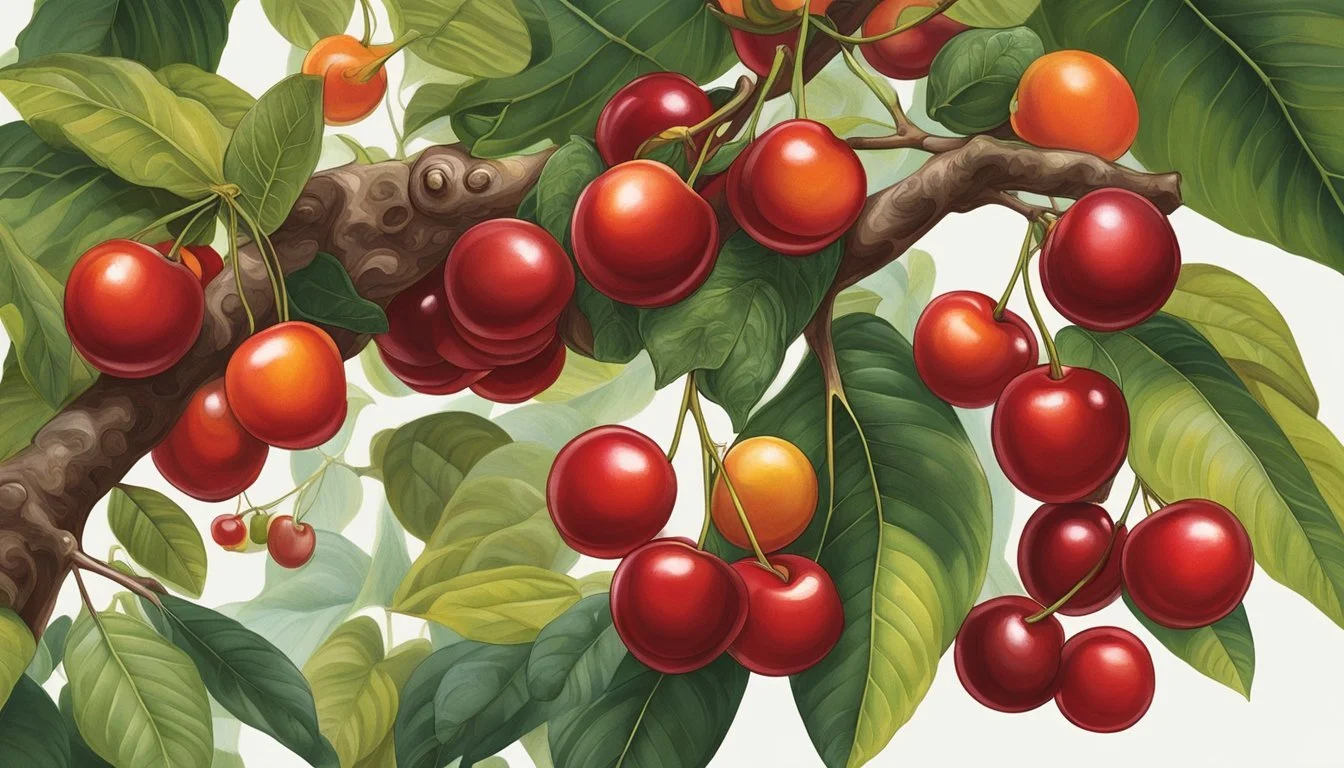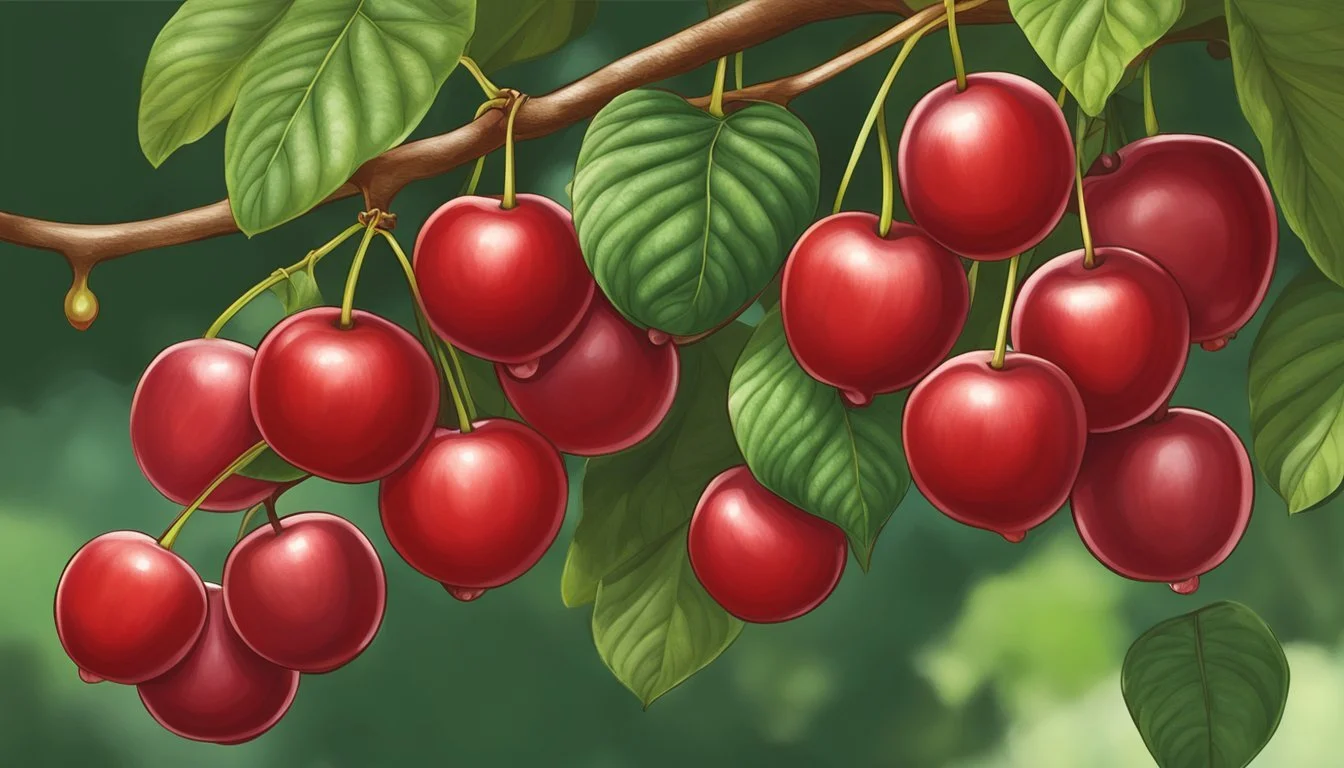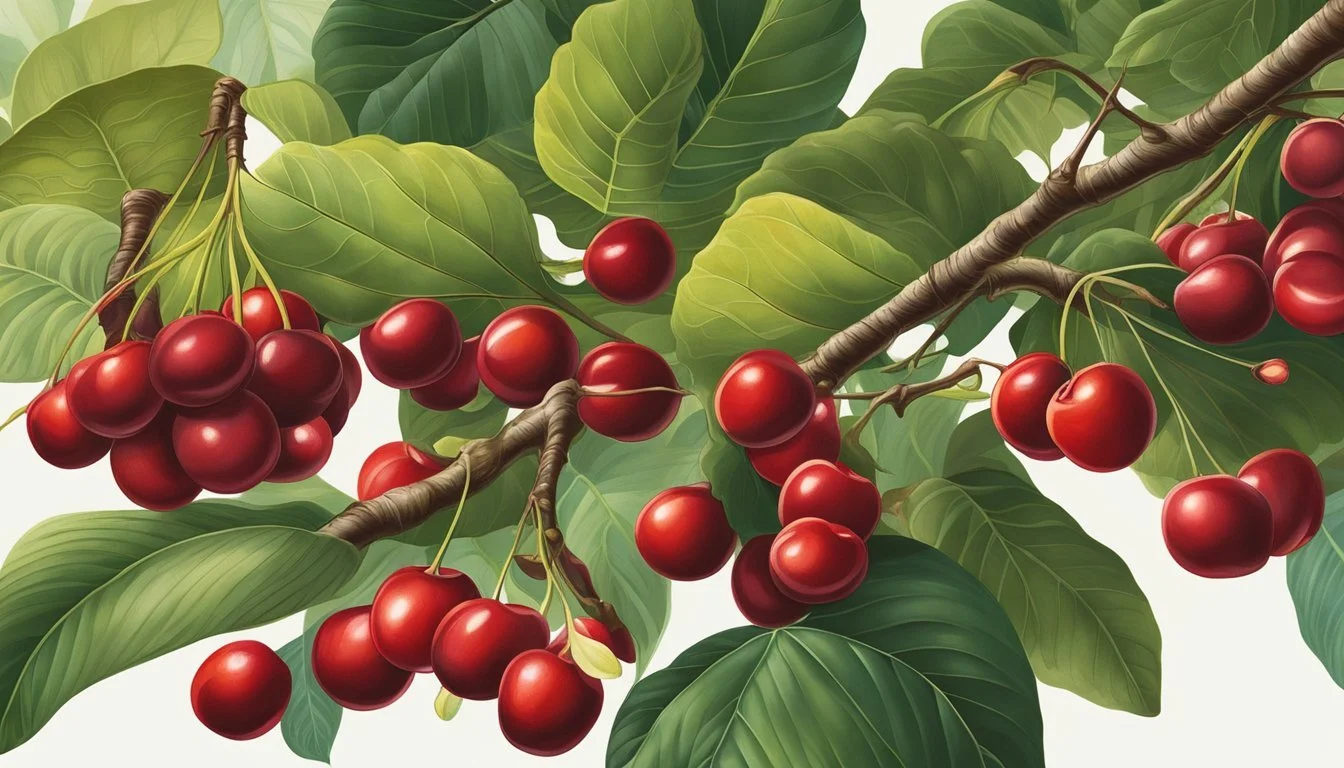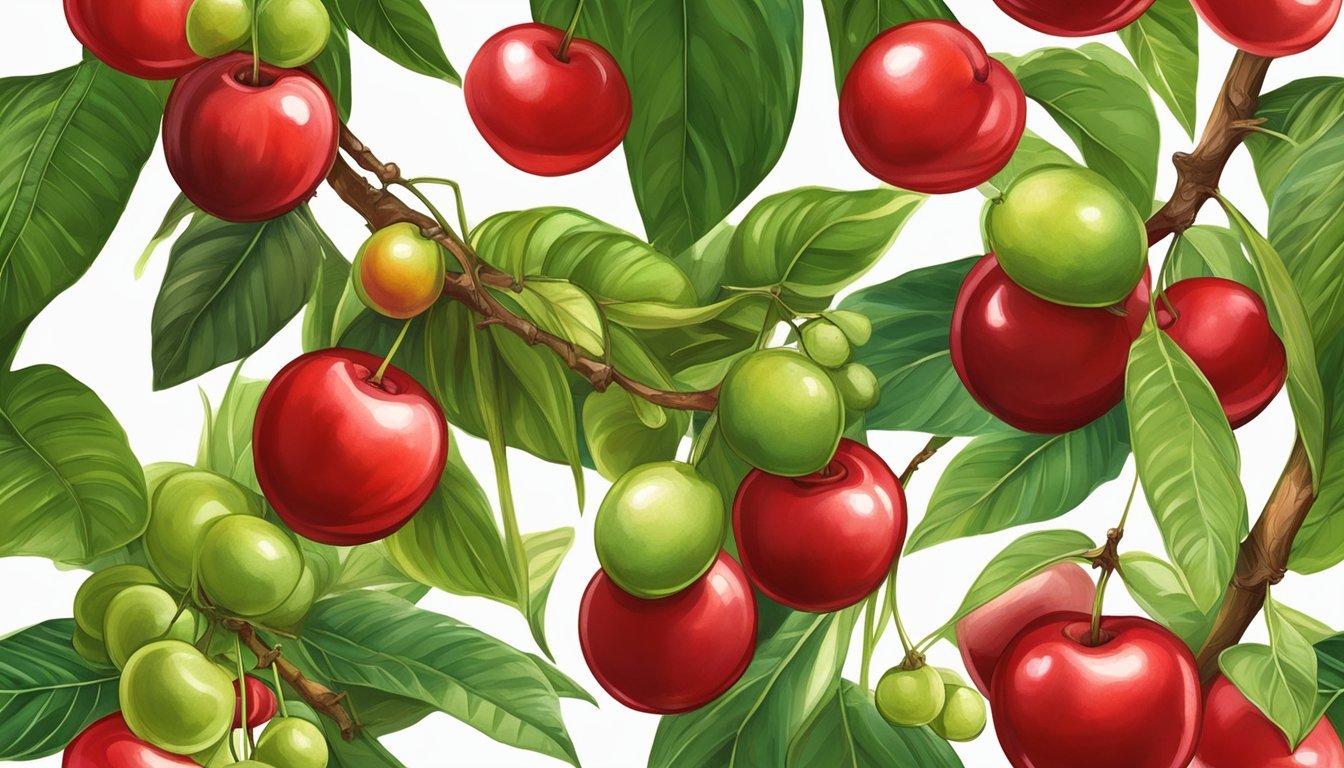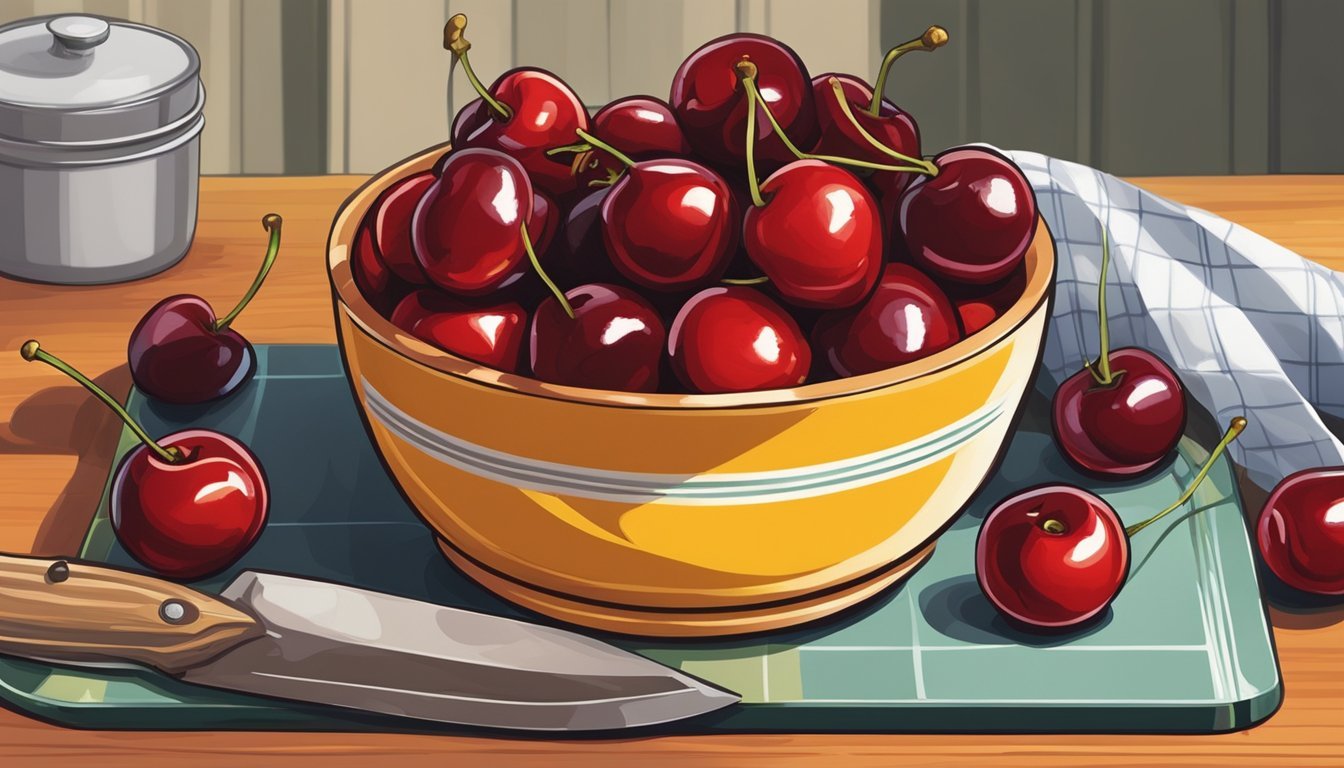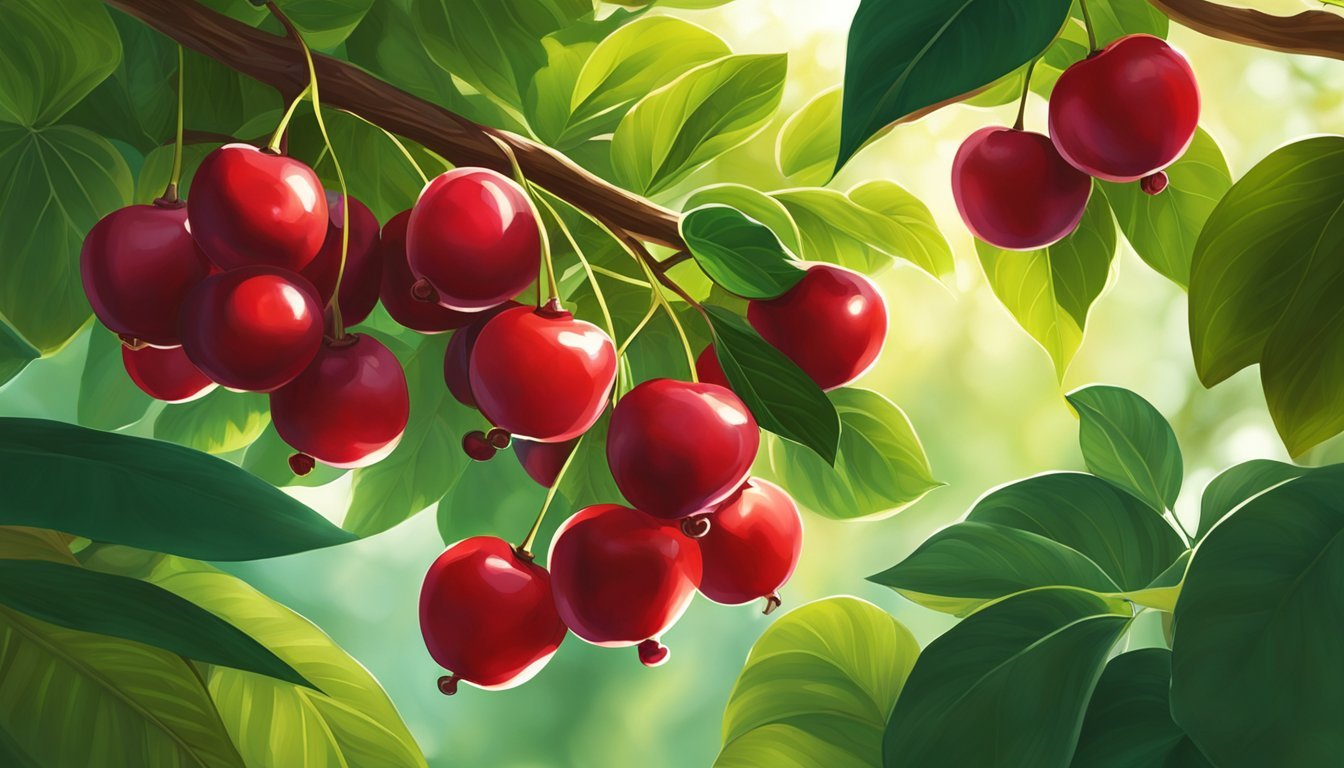How to Tell If Surinam Cherries Are Ripe
Essential Tips for Perfect Picking
Surinam cherries, or Pitanga, are tropical fruits that boast a unique taste and are a rich addition to the fruit palette. Recognizing the ripeness of Surinam cherries is crucial for enjoying their optimal flavor and nutritional benefits. These cherries change color through a vivid spectrum from green to black, indicating their journey to peak ripeness. The darker the fruit, the sweeter it is, and the most preferred are those that have reached a nearly black hue.
Growing Surinam cherries involves selecting the right environment and understanding their cultivation needs, such as full sun exposure and well-drained soil. It is essential to choose the proper location and soil for planting these cherries for successful growth. As one gets into the specifics of Surinam cherries, it becomes apparent that varieties differ in sweetness and color intensity. This range from bright red to dark purple is not only appealing to the eye but is also indicative of the subtle flavor differences within the species.
Key Takeaways
Ripeness of Surinam cherries is indicated by color change, with the darkest fruits being the sweetest.
Proper cultivation and environmental conditions are essential for the optimal growth of Surinam cherries.
Varieties of Surinam cherries offer distinct flavors and colors, from bright red to almost black.
Identifying Surinam Cherries
Recognizing Surinam cherries and determining their ripeness is crucial for a flavorful harvest. This section provides essential characteristics and ripeness indicators of Surinam cherries.
Physical Characteristics
Surinam cherries, also known as pitanga, are easily identifiable by their unique attributes. They exhibit a distinct wedge shape, resembling miniature pumpkins. The fruit's color progresses through various stages, starting from green, transitioning to shades of yellow and orange, and finally reaching a spectrum of reds, from bright red to dark-crimson and dark burgundy. The texture of the Surinam cherry is smooth with a notable glossy sheen when fully ripe.
Ripeness Indicators
To ensure you are picking Surinam cherries at the optimal time, observe the following ripeness indicators:
Color: A ripe Surinam cherry typically acquires a reddish maroon to dark burgundy color, signifying peak sweetness.
Texture: The fruit should yield slightly to gentle pressure, indicating ripeness without being overly soft, which might signal over-ripeness.
Appearance: The glossy exterior and absence of green areas are indicative of a ripe cherry.
Each fruit encases a central seed, which should be avoided when consuming the fleshy part of the fruit.
Varieties and Flavors
Surinam cherry, known scientifically as Eugenia uniflora, offers a range of flavors across its varieties, from resinous to sweet. Various types have been cultivated to enhance taste profiles, adapting to regional preferences and climatic conditions.
Comparing the Flavors
The taste profile of Surinam cherries can vary significantly between types. Red varieties are often associated with a more resinous flavor, which can be an acquired taste, whereas selections with darker fruits are noted for their sweeter and less astringent taste. For example:
Red Surinam Cherry: A large fruit with more flesh and a small pit, possessing a resinous taste that is less dominant compared to other red types.
Black Surinam Cherry: Nearly black when ripe, offering a sweeter flavor, with less of the resinous quality.
Regional Varieties
Different regions may favor distinct varieties of Surinam cherries, often labelled colloquially, such as Florida Cherry or Brazil Cherry, correlating with where they are grown:
Florida Varieties: Known for a selection that tends to a less resinous flavor, making them more palatable even when not fully ripe.
Brazil Varieties: Tend to offer a variety of ripe fruit flavors, with some being sweet enough to be consumed directly off the tree.
Each variety's flavor profile is influenced by the level of ripeness, with deeper red to black fruits indicating a higher sugar content and a richer taste. It's important to note that unlike some stone fruits, cherries do not ripen after being picked; thus, the optimal time of harvest is critical for ensuring the best flavor.
Cultivation Techniques
Successful cultivation of Surinam cherries hinges on understanding and providing the appropriate planting conditions and consistent care. By focusing on these factors, gardeners can ensure the optimal growth and development of this tropical shrub.
Planting Conditions
Soil Requirements: Surinam cherries thrive in well-draining soil with a pH range of 5.6 to 7.5, which is acidic to neutral. While not overly fastidious regarding soil types, gardeners should avoid saline environments as the shrub is not salt-tolerant.
Ideal Soil Composition:
Sand: Ensures good drainage.
Organic Matter: Enriches the soil.
pH Level: Acidic to neutral.
Sunlight and Temperature: They require full sun to promote dense foliage and abundant fruiting, but can endure light shade. The Surinam cherry prefers warm climates with average temperatures in the 70s (Fahrenheit) or higher. Gardeners should safeguard the shrubs from frost, as the Surinam cherry is not cold-hardy.
Sunlight: Full sun to part shade
Minimum Temperature: Avoid temperatures lower than 30°F (-1°C)
Care and Maintenance
Watering Regimen: Initially, water the Surinam cherry shrubs modestly until they are well-established. Once established, they exhibit good tolerance to drought but shouldn't be exposed to standing water for prolonged periods.
Early Growth: Regular watering to establish roots.
Mature Growth: Tolerant of drier conditions; avoid waterlogging.
Fertilization and Growth: To support their growth rate, gardeners may apply a balanced, slow-release fertilizer according to the manufacturer's instructions. During the growing season, light applications of fertilizer can encourage more vigorous growth and fruit production.
Fertilizer Type: Balanced, slow-release formula
Application Frequency: Follow manufacturer’s guidelines or use sparingly during growing season
Regular inspection for pests and diseases, combined with appropriate preventive measures and treatments, is recommended to maintain healthy shrubs. Pruning may be necessary to shape the plant or to remove any dead or diseased branches, promoting better air circulation and light penetration.
Propagation and Pruning
Proper propagation and pruning are critical for the successful growth and fruit production of Surinam cherry plants. These practices not only influence the plant's health but also its ability to produce ripe fruits.
Pruning Practices
Pruning is ideally conducted in the spring, synchronizing with the Surinam cherry's natural growth cycle. Gardeners should prune as the plant exits winter dormancy but before the burst of spring growth. This timing encourages healthy regeneration and flowering.
Key steps in pruning:
Remove dead or damaged branches to maintain plant health.
Shape the plant, especially if it is used as a hedge, by trimming to promote dense growth.
After the fruiting season, light pruning helps to stimulate the next season's growth.
Plant Propagation
Surinam cherry plants can be propagated via seeds or cuttings.
Plant seeds in a well-draining potting soil.
Water the seeds sparingly and expect germination in 3-4 weeks.
Seedlings can be ready for transfer to the garden in 6-8 months.
Cutting Propagation:
Take cuttings from a healthy Surinam cherry plant.
Use a rooting hormone for higher success rates.
Plant cuttings in a similar well-draining soil and keep them moist.
In both methods, patience is key; fruit production typically begins 3-5 years after planting.
Health Benefits and Nutrients
Surinam cherries are nutrient-dense, offering an array of vitamins and antioxidants that contribute to overall health. They are particularly noted for their vitamin C and fiber content.
Vitamin Content
Vitamin C: Surinam cherries provide a substantial amount of vitamin C, essential for immune system function, skin health, and collagen synthesis. A 100-gram serving typically offers 30 mg of vitamin C, which is around 50% of the recommended daily value.
Vitamins A: Alongside vitamin C, Surinam cherries are also a source of vitamin A, important for vision, immune function, and organ maintenance.
Antioxidant Properties
Surinam cherries contain antioxidants which help combat oxidative stress and may reduce the risk of chronic diseases. These antioxidants include a variety of phytochemicals that contribute to the fruit’s vibrant color and health-promoting qualities.
Fiber: The fruit's fiber content supports digestive health, wherein a 100-gram serving provides about 2 grams of fiber.
Other Antioxidants: Beyond vitamins C and A, Surinam cherries also possess numerous other compounds with antioxidant properties, contributing to their overall nutritional value.
Harvesting and Storing
Properly harvesting and storing Surinam cherries are vital to maintaining their flavor and freshness. Surinam cherries reach optimal ripeness when they transition from orange to red and finally to a nearly black hue. The precise moment of harvest impacts both the cherry taste and shelf life.
Best Harvest Time
Surinam cherries are ready to be harvested when they exhibit a deep, nearly black color, indicating peak sweetness. They contain a single seed, which remains within the fruit upon picking. The best time for harvesting is in the morning when temperatures are cooler. This minimizes stress on the fruit, preserving its quality.
Storage Tips
After harvesting, Surinam cherries should be handled delicately to prevent bruising. For optimal storage, consider the following guidelines:
Inspect the cherries: Remove any damaged or overripe fruits to avoid spoilage.
Refrigeration: Store the cherries in a refrigerator at a temperature between 32°F to 40°F.
Humidity Control: Maintain moderate humidity in the storage environment to prevent drying out.
Airtight Containers: Use airtight containers or resealable plastic bags to protect the cherries from absorbing other odors.
Consume Promptly: Even with proper storage, Surinam cherries have a limited shelf life and are best consumed within a few days after harvest.
Pests and Diseases
When cultivating Surinam cherries, it’s essential to be aware of the potential pests and diseases that could affect the health of the plant and the quality of the fruit.
Common Pests
Surinam cherries can attract various pests. Birds are particularly fond of the ripe fruit and may need to be deterred using netting. Honeybees and butterflies generally do not pose a problem, as they are pollinators which can actually benefit the plant. However, other insects such as fruit flies can infest the cherries, laying eggs inside the fruit. Regular monitoring and good sanitation practices can help minimize their impact.
Birds: netting may be used to protect fruit
Honeybees/Butterflies: typically beneficial pollinators
Fruit Flies: remove affected fruit to prevent spread
Disease Prevention
Surinam cherry trees can be susceptible to certain diseases, but good cultural practices can prevent most issues. It’s important to avoid overhead watering which can promote fungal diseases. Regular pruning to maintain airflow around the foliage and removal of any fallen debris also helps in preventing fungal growth. For those growing Surinam cherry as a landscaping plant, it's critical to ensure proper spacing to reduce disease spread.
Preventative Measures:
Avoid overhead watering to minimize fungal risks
Prune regularly to ensure good airflow
Remove fallen leaves and fruit
Uses in Cooking and Garnishing
The Surinam cherry, with its distinctive flavor profile, is a versatile tropical fruit that can enrich both sweet and savory dishes. When incorporated into meals, its taste can range from tart to sweet, depending on ripeness.
Desserts and Jams
Surinam cherries are an excellent addition to various desserts. Their unique flavor makes them ideal for creating:
Jellies: With their high pectin content, Surinam cherries set well into firm, flavorful jellies.
Jams: The fruit's flesh, rich in both flavor and color, lends itself to sweet and tangy jams, perfect for spreading on toast or filling pastries.
Savory Dishes and Salads
In savory applications, Surinam cherries bring a tropical twist:
Sauces: Their tangy essence can be reduced into a sauce that complements meat dishes, such as pork or duck.
Fruit Salads: Tossed into a fruit salad, Surinam cherries add a burst of color and a balance of sweet-tart flavors, pairing well with other tropical fruits.
Landscaping and Ornamental Value
The Surinam cherry, also known as Pitanga or Florida cherry, is prized for its dual functionality as both a fruit-bearing plant and an ornamental shrub, enhancing the aesthetic of both indoor and outdoor spaces.
As a Hedge Plant
The Surinam cherry tree serves excellently as a hedge plant due to its dense foliage and rapid growth rate. Gardeners often leverage its lush, green leaves and attractive cherry blossoms to create living fences that offer privacy and noise reduction. When cultivated as a hedge, it's essential to provide regular pruning to maintain the desired shape and health of the plant.
Attributes: Dense foliage, rapid growth, cherry blossoms.
Functionality: Privacy, noise reduction.
Maintenance: Requires regular pruning.
Indoor and Outdoor Aesthetics
Indoors, Surinam cherry can be grown in large pots and as bonsai, where its vibrant color and unique shape can contribute to the room's decorative elements. Outdoors, its striking appearance, displaying fruits that transition through a palette of greens, yellows, oranges, to deep reds or nearly black, makes it a standout in landscaping designs. The plant's resilience to various soil types and climates, with the exception of extremely cold or salty conditions, makes it a viable option for many gardeners.
Indoor Use: Pots, bonsai.
Outdoor Use: Colorful landscaping element.
Conditions: Tolerant to various soils, not cold or salt-hardy.
Ecological Considerations
When cultivating Surinam cherries, gardeners should consider the plant's impact on local ecosystems, particularly in relation to wildlife interactions and the risk of invasiveness. These factors are pivotal for both preserving natural habitats and ensuring sustainable fruit production.
Attracting Wildlife
Surinam cherries, part of the Myrtaceae family, which also includes mountain apple and gooseberry, are attractive to a variety of wildlife. The fragrant white flowers and the resultant fruit invite an array of pollinators and birds. Planting these cherries can support food forest designs, where such dynamic ecosystems benefit from the addition of this fruit-bearing shrub. In landscaping, Surinam cherry can serve as both an ornamental feature and as a means to enhance biodiversity by providing:
Nectar for bees and butterflies during flowering seasons.
Fruits that serve as a food source for birds, contributing to seed dispersal.
Invasive Potential
Despite their utility in attracting wildlife, Surinam cherries have a tendency to become invasive outside their native habitats in South America. They are hardy and can adapt to various climates, spreading easily if not properly managed. This aspect is of particular concern as the plant can outcompete native species and disrupt local ecosystems.
Key points for managing the invasive potential of Surinam cherries include:
Monitoring spread in regions outside of their native range.
Removing seedlings from unwanted areas to control growth.
By considering these ecological considerations, growers can ensure that their cultivation of Surinam cherries contributes positively to their local environment.
Cultural Significance
In South America, particularly in its native range that includes countries such as Brazil, the Surinam cherry, or Eugenia uniflora, holds notable cultural significance. It is often found in home gardens and is valued for both its ornamental beauty and its flavorful fruit. The Surinam cherry is embedded in culinary and medicinal traditions where it is native.
Traditional Uses:
Food: Surinam cherries are eaten fresh or used in various dishes, jams, and beverages.
Medicine: The fruit is traditionally used for its medicinal properties, including its antiseptic and astringent effects.
In Brazilian culture, the fruit bears the name "pitanga" and is beloved for its unique flavor profile. It's a common sight at local markets, and Brazilians often recall fond memories of picking the ripe cherries straight from the tree. The bright red color of a ripe Surinam cherry is a celebrated indicator of its readiness to be enjoyed.
Brazilian Heritage:
Festivals: Surinam cherry is sometimes incorporated into local festivals and culinary events.
Symbolism: The tree itself, with lush foliage and vibrant fruits, symbolizes prosperity and fertility in some communities.
Given the tree's ease of cultivation and hardiness, it has spread from South America to other tropical regions, where it has been assimilated into local cultural practices. However, it is in South America that the Surinam cherry is most closely tied to the cultural fabric of society, indicative of the region's biodiversity and the integration of native species into daily life.
Conclusion
Determining the ripeness of Surinam cherries is crucial for experiencing their optimal flavor. They transition through a spectrum of hues as they ripen and are ideally picked when they reach a nearly black shade. One should avoid eating the cherries when they are orange-red, as they may taste unpleasant.
Ripeness Indicators:
Color Progression: Green → Yellow → Orange → Red → Nearly Black
Taste: The darker the cherry, the sweeter it will be.
Surinam cherries provide a unique addition to one's garden, thriving in warm climates with well-drained soil and partial shade. They are relatively low-maintenance, drought-tolerant, and can flourish in various soil conditions. Additionally, the white fragrant flowers serve as a lovely ornamental feature.
Best Practices:
Climate: Warm, with temperatures in the 70s (Fahrenheit)
Soil: Tolerates most types, but not salt marshy areas
Sunlight: Full sun to partial shade
Watering: Modest until established
When consuming Surinam cherries, they should always be fully ripe to avoid a disagreeable taste. By employing patience and allowing the fruit to fully mature on the shrub, one can enjoy the delightful sweetness that ripe Surinam cherries offer.

